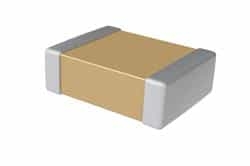source: Kemet news
GREENVILLE, SC–(Marketwired – January 17, 2017) – Offer miniaturization and enhanced flexibility to optimize filtering, tuning, decoupling or ESD-protection circuitry. Available in automotive grade with voltage ratings up to 200 volts.
KEMET Corporation (NYSE: KEM), a leading global supplier of electronic components, has introduced electrostatic discharge (ESD) rated ceramic capacitors in small 0603 EIA case size (metric 1608), providing designers a choice of either X7R or C0G dielectric for circuits requiring Class-II or Class-I stability and noise performance. Automotive and commercial grades are available, and a special ordering code allows customers to obtain automotive-grade parts for their projects without submitting a drawing or specification.
“Electrostatic discharge events can cause undesirable operation in a circuit and possibly damage components. ESD damage due to human contact is a major cause of electronic equipment failures during circuit assembly or in the field, and is estimated to reduce assembly-line productivity by up to 33%,” said John Bultitude, Vice President and Technical Fellow, Ceramic Technology at KEMET. “KEMET’s ESD-rated MLCCs enhance protection for the lifetime of the equipment, and their small dimensions simplify design and minimize impact on overall form factor.”
X7R capacitance values from 1 nF to 220 nF (C0G from 1 nF to 15 nF) give designers flexibility to achieve their desired frequency response in RF filtering, decoupling, tuning or resonant circuits. The lower capacitance values are ideal for providing ESD protection at external ports such as USB 3.0, DisplayPort, HDMI, serial ports, audio jacks, and SIMs or memory cards. They also provide ESD protection for automotive modules such as infotainment equipment, airbag controllers or keyless entry systems, as well as industrial computers, video cameras, and test and measurement equipment.
These capacitors have up to 25 kV ESD-withstanding capability and pass AEC-Q200-002 HBM (Human-Body Model) tests. Automotive-qualified devices additionally meet all other requirements of AEC-Q200. Voltage ratings from 25 V to 200 V are available, and devices can be specified with tolerance of ±5%, ±10% or ±20% on capacitance value. C0G capacitors are also available with ±1% or ±2% tolerance. The operating-temperature range of -55°C to 125°C ensures high reliability in a wide range of applications and optional flexible terminations enhance robustness in designs exposed to extreme mechanical stresses or temperature cycling.































